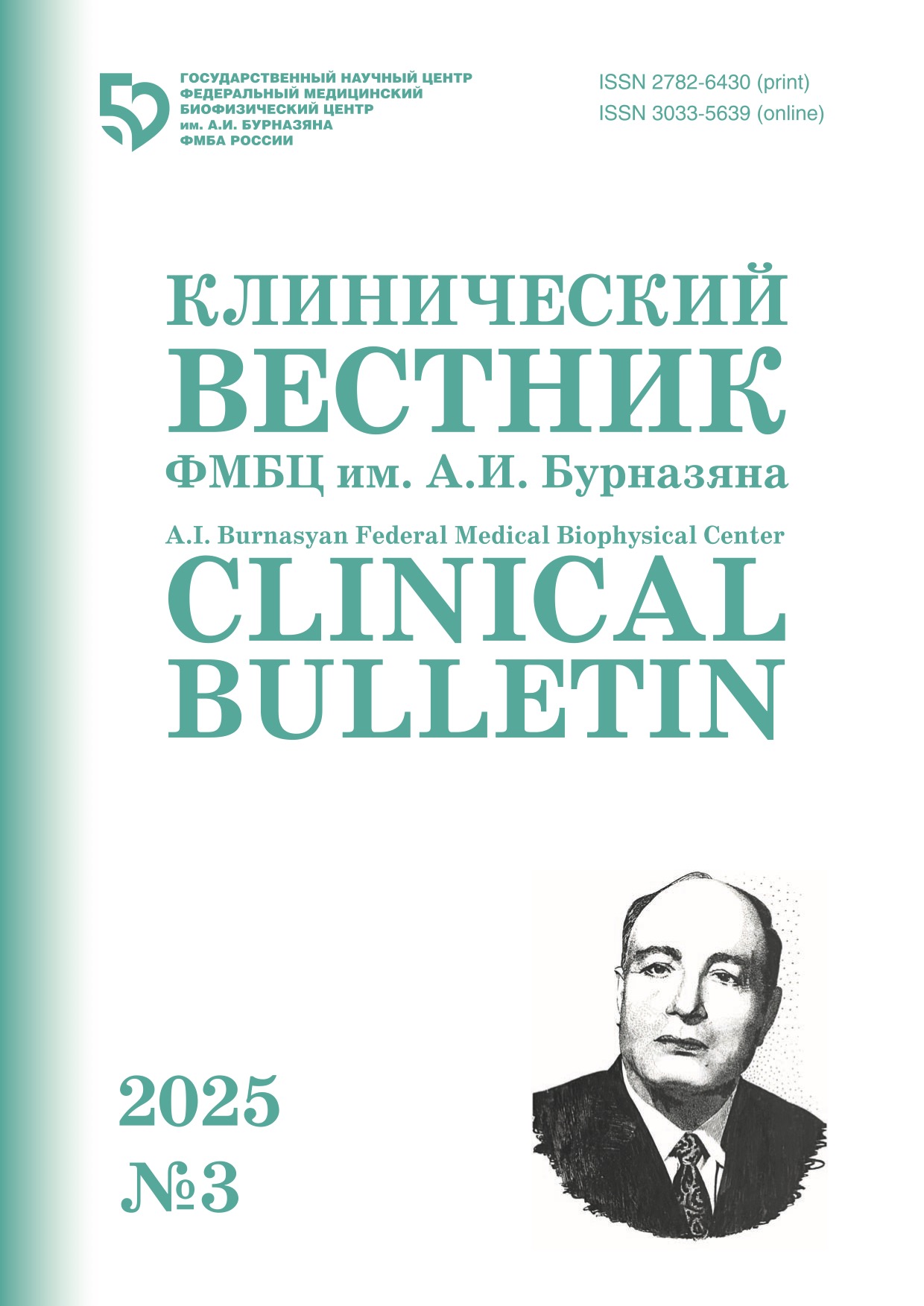A.I. Burnasyan FMBC clinical bulletin. 2024 № 4
I.V. Tsymbal ¹, M.S. Semenov ¹, V.A. Brunchukov ¹, E.A. Dubova ¹, G.G. Stepanyan ¹, L.T. Lepsveridze ¹, S.V. Lischuk ¹,
T.A. Astrelina ¹, I.V. Kobzeva ¹, Yu.B. Suchkova ¹, O.F. Serova ², A.S. Samoilov ¹, O.V. Parinov 1,2
The Usage of an Amniotic Membrane to Minimize Pathological Scarring
in Nerve Neurotization Surgery
1International Office, State Research Center – Burnasyan Federal Medical Biophysical Center of Federal Medical Biological Agency, Moscow, Russiа
2Moscow regional Perinatal Center, Russia, Moscow region, Balashikha
Contact person:Semenov Maxim: semenovfmbc@gmail.com
Abstract
Despite modern advances in surgery, the problem of pathological scarring is still remains relevant. It can lead to both serious dysfunctions of various organ systems and cosmetic defects, which significantly reduces the quality of patients’ life. In search of effective methods for the prevention of scarring, we paid attention to the amniotic sac, which, due to its properties, is able to provide tissue protection and prevent scar-adhesive processes. We have illustrated the positive results of the amnion usage in surgery of sciatic nerve neurotization in rabbits; a safety and effectiveness of this method have been also presented. The amniotic sac is a promising biomaterial for the prevention of pathological scarring and improvement of postoperative outcomes. However, further research and standardization of production are needed for its widespread use.
Keywords: venetoclax, relapsed or refractory B-cell lymphomas, survival, complete remission
For citation: Tsymbal IV, Semenov MS, Brunchukov VA, Dubova EA, Stepanyan GG, Lepsveridze LT, Lischuk SV, Astrelina T.A., Kobzeva I.V., Suchkova Yu.B., Serova O.F., Samoilov A.S., Parinov O.V.The Usage of an Amniotic Membrane to Minimize Pathological Scarring in Nerve Neurotization Surgery A.I. Burnasyan Federal Medical Biophysical Center Clinical Bulletin. 2024.4:34-39. (In Russian) DOI: 10.33266/2782-6430-2024-4-34-39
REFERENCES
- Velnar T., et al. The Wound Healing Process: an Overview of the Cellular and Molecular Mechanisms. J Int Med Res. 2009;37;5:1528-1542.
- Reinke J.M., Sorg H. Wound Repair and Regeneration. Eur Surg Res. 2012;49;1:35-43.
- Koh T.J., DiPietro L.A. Inflammation and Wound Healing: the Role of the Macrophage. Expert Rev Mol Med. 2011;13:e23.
- Barrientos S., et al. Growth Factors and Cytokines in Wound Healing. Wound Repair Regen. 2008;16;5:585-601.
- Desmoulière A., et al. Transforming Growth Factor-Beta 1 Induces Alpha-Smooth Muscle Actin Expression in Granulation Tissue Myofibroblasts and Quiescent and Growing Cultured Fibroblasts. J Cell Biol. 1993;122;1:103-111.
- Tracy L.E., et al. The Roles of Myofibroblasts in Wound Healing and Fibrosis. Transl Res. 2021;228:32-46.
- Velnar T, et al. The Wound Healing Process: an Overview of the Cellular and Molecular Mechanisms. J Int Med Res. 2009;37;5:1528-1542.
- Xue M., Jackson C.J. Extracellular Matrix Reorganization During Wound Healing and its Impact on Abnormal Scarring. Adv Wound Care (New Rochelle). 2015;4;3:119-136.
- Hinz B., et al. Myofibroblast Development Is Characterized by Specific Cell-Cell Adherens Junctions. Mol Biol Cell. 2004;15;9:4310-20.
- Reinke J.M., Sorg H. Wound Repair and Regeneration. Eur Surg Res. 2012;49;1:35-43.
- Desmoulière A., et al. Apoptosis Mediates the Decrease in Cellularity During the Transition Between Granulation Tissue and Scar. Cell Death Differ. 1995;2;3:175-187.
- Xue M., Jackson C.J. Extracellular Matrix Reorganization During Wound Healing and its Impact on Abnormal Scarring. Adv Wound Care (New Rochelle). 2015;4;3:119-136.
- Reinke J.M., Sorg H. Wound Repair and Regeneration. Eur Surg Res. 2012;49;1:35-43.
- Bayat A., et al. Genetic Susceptibility to Keloid Disease and Hypertrophic Scarring: Transforming Growth Factor β1 Common Polymorphisms. Plast Reconstr Surg. 2003;111;2:634-646.
- Deeken C.R., et al. Prospective Evaluation of Molecular-Enriched Dermal Matrix in Development of Human Adipose-Derived Stem Cell-Based Therapies for Scarring. Stem Cells Transl Med. 2016;5;2:212-225.
- Cirman T., et al. Amnion Membrane Matches the Healing Characteristics of Preterm Neonatal Skin. Placenta. 2021;107:21-29.
- Bailo M., et al. Engraftment Potential of Human Amnion and Chorion Cells Derived from Term Placenta. Transplantation. 2004;78;10:1439-1448.
- Zhang D., et al. Amniotic Membrane Extract Inhibits Oxidative Stress and Profibrotic Pathways in Human Fibroblasts Via a Novel Transcription Factor Nanoparticle Construct. Biomaterials. 2019;192:141-153.
- Niknejad H., et al. Inhibition of Protease-Activated Receptor-2 Induces Differential Expression of Transforming Growth Factor-Beta and Impacts its Signaling Pathways. Int J Biochem Cell Biol. 2014;48:93-103.
- Mamede A.C., et al. Amniotic Membrane: from Structure and Functions to Clinical Applications. Cell Tissue Res. 2012;349;2:447-458.
- Wolbank S., et al. Cytokine-Regulated Expression of Suppressed NF-kappaB Gene Products Comprises a Model for Inflammation-Related Anti-Apoptotic Signaling in Human Amniotic Membrane-Derived Cells. J Cell Biochem. 2010;111;1:1-11.
- Buhimschi C.S., et al. The Novel Stem Cell Biology of Human Amnion and its Therapeutic Applications. FASEB J. 2022;36;3:e22215.
- Koizumi N., et al. Growth Factor mRNA and Protein in Preserved Human Amniotic Membrane. Curr Eye Res. 2000;20;3:173-177.
Conflict of interest. The authors declare no conflict of interest.
Financing. The study had no sponsorship.
Contribution. Article was prepared with equal participation of the authors.
Article received: 13.09.2024. Accepted for publication: 11.10.2024


